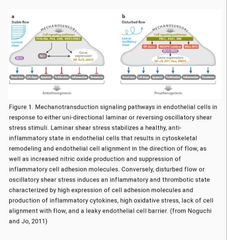![]()
![]()
![]()
Use LEFT and RIGHT arrow keys to navigate between flashcards;
Use UP and DOWN arrow keys to flip the card;
H to show hint;
A reads text to speech;
20 Cards in this Set
- Front
- Back
- 3rd side (hint)
|
What is the endothelial Glycocalyx |
The glycocalyx is a complex gel layer that coats all healthy vascular endothelium. This layer exists in dynamic interaction between flowing blood and the endothelial cell wall. It plays a pivotal role in vascular protection, modulation and haemostasis. |
|
|
|
What is the endothelial Glycocalyx composed of?. 2. |
Glycoproteins and proteoglycans. |
|
|
|
How do proteoglycans differ? |
They differ in size, number of GAG side chains & whether they attach to the cell membrane or not. |
|
|
|
Name the types of Proteoglycans? .2 |
Those that First bind to cell membrane & attach Gags later syndecans & glypicans Those that First Bind GAG & then r secreted by the endothelial cell. perlecans, mimecans, biglycans, decorins & versicans. |
|
|
|
Describe the structure of Proteoglycans |
Proteoglycans have a protein core to which are attached negatively charged glycosaminoglycan (GAG) side chains. |
|
|
|
List the 5 types of GAG side chains |
Heparin 50-90% Hyluronic acid: the only GAG NOT bound to a core protein & forms viscous solutions with water. Dermatin Chondroitin Keratin |
|
|
|
What is the function of Glycoproteins within the Endothelial Glycocalyx? .2. |
1. act as adhesion molecules and contribute to the coagulation, fibrinolytic and haemostatic systems. These include E and P selectin which are expressed after stimulation by histamine, thrombin, interleukin-1 and tumour necrosis factora (TNF-α). 2. Ligands for leucocyte and platelet adhesion ICAM-1, ICAM-2, VCAM-1, PECAM-1 are also expressed within the glycocalyx. |
|
|
|
Describe the Sieve effect / function of the Endothelial Glycocalyx? Does Albumin permeate the Glycocalyx? Explain. |
The charged mesh of the glycocalyx acts as a macromolecular sieve, repelling negatively charged molecules, as well as white and red blood cells and platelets. Macromolecules larger than 70 kDa are excluded from the glycocalyx. Albumin is 67 kDa and thus leaks through the glycocalyx despite its mostly negative charge. However it does also carry positive charge, and this amphoteric nature helps it to also bind to the glycocalyx. This binding reduces the hydraulic conductivity across the vascular barrier |
|
|
|
What is the role of the Endothelial Surface Layer & how is it formed.? |
The ESL regulates vascular permeability, influences blood cell-vessel wall interactions, affects rheology and controls the microenvironment. The binding of plasma constituents to the inert framework of glycocalyx produces the physiologically active endothelial surface layer (ESL)1 |
Rheology = deformation & flow of a fluid. |
|

Starling Principle. How has this been revised? |

|
|
|
|
List the three components of starling equation that were revised. |
1.Sustained venous reabsorption does not occur in most tissues, only in specialized tissues like the kidney and intestines. And Lymphatic drainage is low. 2. Capillary filtration rate is much less than Starling predicted. Why is the capillary filtration rate it less than Starling predicted? And how is this possible? 3) The endothelial surface layer reduces hydraulic conductivity. Oncotic forces are only set up across the endothelial surface layer on the luminal aspect of the endothelial cell, not across the whole capillary wall. Capillary filtration rate is tightly regulated. The oncotic pressure differences across the endothelial surface layer reach equilibrium very quickly, thereby leading to less fluid filtration. |
|
|
|
What are the pathological process that affect glycocalyx integrity, cause shedding & disruption? |
1) Ischaemia/reperfusion 2) Sepsis 3) Volume loading 4) Hyperglycaemia 5) Atherosclerosis 6) Trauma/cardiac and aortic bypass surgery |
|
|
|
What are the effects of Shedding of Glycocalyx.? 5. |
- capillary leak - oedema - accelerated inflammation - platelet aggregation - hypercoagulability - loss of vascular responsiveness |
|
|
|
Why is it difficult to assess the Glycocalyx? |
The glycocalyx is a difficult structure to visualize because it is destroyed by conventional dyeing and fixation techniques. Dynamic assessment of the glycocalyx is also difficult and current technologies are not readily available |
|
|
|
Examples of Novel technology that can assess the endothelial glycocalyx. |
current technologies are not readily available and can only assess the glycocalyx in easily assessible parts of the circulation, eg. sublingual microcirculation. These novel technologies are: Orthogonal polarization spectral imaging (OPS) and side-stream dark field imaging (SDF). |
|
|
|
List therapies that may provide benefit to the endothelial glycocalyx. |
-Avoiding hyperglycaemia -Albumin -Steroids in septic shock -Sevoflurane -Avoiding hypervolaemia -Statins Therapies such as TNF inhibition, antithrombin III and infusions of glycocalyx constituents are still experimental. |
|
|
|
What is the role of the Endothelial Glycocalyx in: A. Immunity B. Fertilization C. Embryonic development. |
A. Defense against cancer: Changes in the glycocalyx of cancerous cells enable the immune system to recognize and destroy them. Inflammation regulation: Glycocalyx coating on endothelial walls in blood vessels prevents leukocytes from rolling/binding in healthy states. B. The spermatozoa glycocalyx is a dynamic coating of extracellular glycoproteins known to facilitate the acrosome reaction and fertilization in mammals C. Included in the glycocalyx are cell-adhesion molecules that enable cells to adhere to each other and guide the movement of cells during embryonic development |
|
|
|
List 3 elements of the Glycocalyx. |
proteoglycans (PG), glycoproteins bound with sialic acid, glycosaminoglycans (GAG), and associated plasma proteins [ |
|
|
|
Explain the Glycocalyx as a mechano-transducer |

|
|
|
|
Role of glycocalyx in the BBB. |
. |
|

